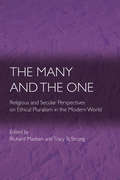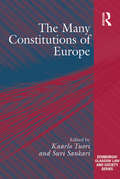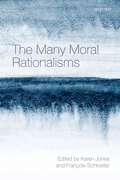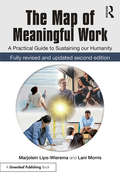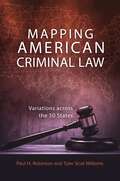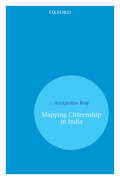- Table View
- List View
The Many and the One: Religious and Secular Perspectives on Ethical Pluralism in the Modern World
by Richard Madsen Tracy B. StrongThe war on terrorism, say America's leaders, is a war of Good versus Evil. But in the minds of the perpetrators, the September 11 attacks on New York and Washington were presumably justified as ethically good acts against American evil. Is such polarization leading to a violent "clash of civilizations" or can differences between ethical systems be reconciled through rational dialogue? This book provides an extraordinary resource for thinking clearly about the diverse ways in which humans see good and evil. In nine essays and responses, leading thinkers ask how ethical pluralism can be understood by classical liberalism, liberal-egalitarianism, critical theory, feminism, natural law, Confucianism, Islam, Judaism, and Christianity. Each essay addresses five questions: Is the ideal society ethically uniform or diverse? Should the state protect, ban, or otherwise intervene in ethically based differences? How should disagreements on the rights and duties of citizens be dealt with? Should the state regulate life-and-death decisions such as euthanasia? To what extent should conflicting views on sexual relationships be accommodated? This book shows that contentious questions can be discussed with both incisiveness and civility. The editors provide the introduction and Donald Moon, the conclusion. The contributors are Brian Barry, Joseph Boyle, Simone Chambers, Joseph Chan, Christine Di Stefano, Dale F. Eickelman, Menachem Fisch, William Galston, John Haldane, Chandran Kukathas, David Little, Muhammad Khalid Masud, Carole Pateman, William F. Scheuerman, Adam B. Seligman, James W. Skillen, James Tully, and Lee H. Yearley.
The Many Constitutions of Europe
by Suvi SankariThis volume makes a contribution to the ongoing lively discussion on European constitutionalism by offering a new perspective and a new interpretation of European constitutional plurality. The book combines diverse disciplinary approaches to the constitutional debate. It brings together complementing contributions from scholars of European politics, economics, and sociology, as well as established scholars from various fields of law. Moreover, it provides analytical clarity to the discussion and combines theory with more practical and critical approaches that make use of the constitutional toolbox in analysing the tensions between the different constitutions. The collection is a valuable point of reference not only for scholars interested in European studies but also for graduate and post-graduate students.
The Many Constitutions of Europe
by Suvi SankariThis volume makes a contribution to the ongoing lively discussion on European constitutionalism by offering a new perspective and a new interpretation of European constitutional plurality. The book combines diverse disciplinary approaches to the constitutional debate. It brings together complementing contributions from scholars of European politics, economics, and sociology, as well as established scholars from various fields of law. Moreover, it provides analytical clarity to the discussion and combines theory with more practical and critical approaches that make use of the constitutional toolbox in analysing the tensions between the different constitutions. The collection is a valuable point of reference not only for scholars interested in European studies but also for graduate and post-graduate students.
The Many Futures of a Decision
by Jay LampertCombining two a central topics in philosophy in the 20th Century, this book considers the ethics and impact of decision-making alongside the philosophy of time.When we make simple decisions, like the decision to wake up at 8 a.m. tomorrow, we make use of a linear model of the future. But when we make open-ended decisions, like the decision to get fitter, or more involved in politics, we presuppose a much more complex model of the future. We project a variety of virtual futures. We can carry out a decision in many different ways at once, which may converge and diverge at different points in time. Using a phenomenological approach, The Many Futures of a Decision explores what we learn about the structure of the future specifically from decision-making. Most theories of decision concentrate on the rationality: the evidence and value assessments that build up grounds for a rational decision. Instead, this book innovatively engages with the nature of the future as a multi-layered decisions project. Through interpretations of the theories of decision in philosophers like Husserl and Heidegger, Schmitt and Habermas, Derrida and Deleuze, along with other decision theories, Lampert develops an original theory of multiple futures.
The Many Futures of a Decision
by Jay LampertCombining two a central topics in philosophy in the 20th Century, this book considers the ethics and impact of decision-making alongside the philosophy of time.When we make simple decisions, like the decision to wake up at 8 a.m. tomorrow, we make use of a linear model of the future. But when we make open-ended decisions, like the decision to get fitter, or more involved in politics, we presuppose a much more complex model of the future. We project a variety of virtual futures. We can carry out a decision in many different ways at once, which may converge and diverge at different points in time. Using a phenomenological approach, The Many Futures of a Decision explores what we learn about the structure of the future specifically from decision-making. Most theories of decision concentrate on the rationality: the evidence and value assessments that build up grounds for a rational decision. Instead, this book innovatively engages with the nature of the future as a multi-layered decisions project. Through interpretations of the theories of decision in philosophers like Husserl and Heidegger, Schmitt and Habermas, Derrida and Deleuze, along with other decision theories, Lampert develops an original theory of multiple futures.
Many Layers of Ecocentrism: Revering Life, Revering the Earth
by Abhik GuptaThis book unveils the myriad streams of ecocentric thoughts that have been flowing through the human mind – in indigenous communities, in the wisdom of philosophers, in the creative expressions of poets and writers – sometimes latent, but sometimes more explicit. The strength of this book lies in the fact that it attempts to show that ecocentrism had not emerged suddenly as a distinct line of philosophical thought or found its place among the various normative approaches toward nature, but the seeds of ecocentrism had always been running through human societies. Thus, this book not only emphasizes the “unity of life” but also reveals the inherent unity of all hues of ecocentrism. The book adopts a multidisciplinary approach, which is essential to dwell on a topic like ecocentrism which permeates the domains of disciplines as disparate as science, philosophy, religion, normative ethics, myths and folklore, poetry, and literature, among others. Despite this eclectic approach, the book attempts to maintain continuity among the chapters and present these concepts in a simple form that will be easily accessible by readers from all conceivable backgrounds. This book would be useful to the students, researchers, and faculty from the fields of ecology and environmental science, philosophy, sociology, religious studies, and literature. It will also be an indispensable companion for all nature lovers, activists, and general readers interested in the emergence and evolution of environmental thoughts.
Many Layers of Ecocentrism: Revering Life, Revering the Earth
by Abhik GuptaThis book unveils the myriad streams of ecocentric thoughts that have been flowing through the human mind – in indigenous communities, in the wisdom of philosophers, in the creative expressions of poets and writers – sometimes latent, but sometimes more explicit. The strength of this book lies in the fact that it attempts to show that ecocentrism had not emerged suddenly as a distinct line of philosophical thought or found its place among the various normative approaches toward nature, but the seeds of ecocentrism had always been running through human societies. Thus, this book not only emphasizes the “unity of life” but also reveals the inherent unity of all hues of ecocentrism. The book adopts a multidisciplinary approach, which is essential to dwell on a topic like ecocentrism which permeates the domains of disciplines as disparate as science, philosophy, religion, normative ethics, myths and folklore, poetry, and literature, among others. Despite this eclectic approach, the book attempts to maintain continuity among the chapters and present these concepts in a simple form that will be easily accessible by readers from all conceivable backgrounds. This book would be useful to the students, researchers, and faculty from the fields of ecology and environmental science, philosophy, sociology, religious studies, and literature. It will also be an indispensable companion for all nature lovers, activists, and general readers interested in the emergence and evolution of environmental thoughts.
The Many Moral Rationalisms
by Karen Jones François SchroeterMoral rationalism takes human reason and human rationality to be the key elements in an explanation of the nature of morality, moral judgment, and moral knowledge. This volume explores the resources of this rich philosophical tradition. Thirteen original essays, framed by the editors' introduction, critically examine the four core theses of moral rationalism: (i) the psychological thesis that reason is the source of moral judgment, (ii) the metaphysical thesis that moral requirements are constituted by the deliverances of practical reason, (iii) the epistemological thesis that moral requirements are knowable a priori, and (iv) the normative thesis that moral requirements entail valid reasons for action. The five essays in Part I ('Normativity') offer contemporary defences or reconstructions of Kant's attempt to ground the normative thesis, that moral requirements entail valid reasons for action, in the nature of practical reason and practical rationality. The four essays in Part II ('Epistemology & Meaning') consider the viability of claims to a priori moral knowledge. The authors of all four essays are sympathetic to a realist moral metaphysics, and thus forgo the straightforward constructivist road to apriority. The four essays in Part III ('Psychology') each grapple with the implications for rationalism of the role of emotions and unconscious processes in moral judgement and action. Together the essays demonstrate that moral rationalism identifies not a single philosophical position but rather a family of philosophical positions, which resemble traditional rationalism, as exemplified by Kant, to varying degrees.
The Many Moral Rationalisms
Moral rationalism takes human reason and human rationality to be the key elements in an explanation of the nature of morality, moral judgment, and moral knowledge. This volume explores the resources of this rich philosophical tradition. Thirteen original essays, framed by the editors' introduction, critically examine the four core theses of moral rationalism: (i) the psychological thesis that reason is the source of moral judgment, (ii) the metaphysical thesis that moral requirements are constituted by the deliverances of practical reason, (iii) the epistemological thesis that moral requirements are knowable a priori, and (iv) the normative thesis that moral requirements entail valid reasons for action. The five essays in Part I ('Normativity') offer contemporary defences or reconstructions of Kant's attempt to ground the normative thesis, that moral requirements entail valid reasons for action, in the nature of practical reason and practical rationality. The four essays in Part II ('Epistemology & Meaning') consider the viability of claims to a priori moral knowledge. The authors of all four essays are sympathetic to a realist moral metaphysics, and thus forgo the straightforward constructivist road to apriority. The four essays in Part III ('Psychology') each grapple with the implications for rationalism of the role of emotions and unconscious processes in moral judgement and action. Together the essays demonstrate that moral rationalism identifies not a single philosophical position but rather a family of philosophical positions, which resemble traditional rationalism, as exemplified by Kant, to varying degrees.
The Many Paths of Change in International Law
by Nico Krisch and Ezgi YildizHow does international law change? How does it adapt to meet global challenges in a volatile social and political context? The Many Paths of Change in International Law offers fresh, theoretically informed, and empirically rich answers to these questions. It traces drivers, conditions, and consequences of change across the different fields of international law and paints a complex and varied picture very much in contrast with the relatively static imagery prevalent in many accounts today. Drawing on inspirations from international law, international relations, sociology, and legal theory, this book explores how international law changes through means other than treaty-making. Highlighting the social dynamics through which different areas and institutional contexts have generated their own pathways, it presents a theoretical framework for tracing change processes and the conditions that affect their success. Based on this framework, each contribution illuminates the paths of change we observe in contemporary international law. The explorations centre on strategies, forms, forces, and social contexts and draw on primary source material and in-depth case studies. Overall, the volume offers a fascinating account of an international legal order in flux-with a dynamic not captured through traditional doctrinal lenses-and helps situate change processes and their varied implications in international law and politics. A relevant book for everyone wanting to understand change and its consequences in international law. This is an open access title. It is made available under a Creative Commons Attribution-Non Commercial-No Derivatives 4.0 International licence. It is available to read and download as a PDF version on the Oxford Academic platform.
The Many Paths of Change in International Law
How does international law change? How does it adapt to meet global challenges in a volatile social and political context? The Many Paths of Change in International Law offers fresh, theoretically informed, and empirically rich answers to these questions. It traces drivers, conditions, and consequences of change across the different fields of international law and paints a complex and varied picture very much in contrast with the relatively static imagery prevalent in many accounts today. Drawing on inspirations from international law, international relations, sociology, and legal theory, this book explores how international law changes through means other than treaty-making. Highlighting the social dynamics through which different areas and institutional contexts have generated their own pathways, it presents a theoretical framework for tracing change processes and the conditions that affect their success. Based on this framework, each contribution illuminates the paths of change we observe in contemporary international law. The explorations centre on strategies, forms, forces, and social contexts and draw on primary source material and in-depth case studies. Overall, the volume offers a fascinating account of an international legal order in flux-with a dynamic not captured through traditional doctrinal lenses-and helps situate change processes and their varied implications in international law and politics. A relevant book for everyone wanting to understand change and its consequences in international law. This is an open access title. It is made available under a Creative Commons Attribution-Non Commercial-No Derivatives 4.0 International licence. It is available to read and download as a PDF version on the Oxford Academic platform.
The Map of Meaning: A Guide to Sustaining our Humanity in the World of Work
by Marjolein Lips-Wiersma Lani MorrisThis book introduces a "Map of Meaning" called the Holistic Development Model, which provides a clear, simple and profound framework of the dimensions and process of living and working meaningfully.Like all reliable maps this one has been carefully tested. It is based on over 15 years' research into the insights and practice of ordinary people. Although the authors borrow from the work of philosophers, psychologists and sociologists to provide evidence and context for their ideas, the main contribution of this book is that it describes how ordinary human beings wrestle with, and give answers to, the questions of "What is meaningful work and a meaningful life?" This innate human knowledge is captured in a practical model that makes understanding and working with issues of meaning clear and accessible to everyone.At an individual level this book helps people to define and stay in contact with what is most important to them as they grapple with the real problems of daily life and suggests how they can stay in charge of keeping the human search for meaning alive, especially in the face of the challenges that exist in organizational life. The authors recognize that in the current economic context a simple map of meaning is essential, precisely because organizational life has become so intensely directed towards a singular economic goal. They argue that it is vital that people have a simple and powerful way to reclaim the significance of meaning in their working lives.There are numerous studies that show conclusively that meaningful work, or its absence, influences some important outcomes in organizational life such as motivation, absenteeism, work behaviour, engagement, job satisfaction, empowerment, stress and performance. But people's humanity and search for meaning, so often compromised at work, is not something that can be mechanised by the latest self-help or managerial technique. It is not something that can be picked up and dropped as convenient. The authors argue that being human is not a fad. Being human is enduring and needs to be taken seriously. Creating meaningful work, therefore, leads to many desired organizational outcomes, but implementing it does require the courage to question some fundamental ways of thinking about business and the integrity to engage with the issues sincerely. At an organizational level this book offers many practical examples of how to build and maintain workplaces that are meaningful to people.The idea that there is a parallel between the meanings, decision-making dynamics and actions of individuals and organizations is central to the structure of this book. It therefore addresses meaning at both individual and organizational level and in the dynamic between them. This is neither a self-help book, nor an organizational systems book; its strength is that it draws together the aspirations of individuals with those of the organizations in which they work.At the same time, this is not a naïve book. One of the strengths of the Holistic Development Model is that it takes tensions, paradoxes and imperfections as a given. They are part of being human and they are part of organizations. The book is not only about the importance of living meaningfully, it is about how to do it. The book is full of stories of people who have worked with the model. They demonstrate the versatility of the model and how it helps them to analyse, speak to, plan around and respond to an enormous variety of everyday issues and situations. It is this resourcefulness the authors would like readers to get from this book and have at their fingertips.This book is primarily written for anyone, from a CEO to a blue-collar worker or consultant, who is interested in creating more meaning and purpose in work and organizations, and who would like to better understand how to get others on board. It is for those searching for ways to re-energize their roles or change their careers. It is for anyone who firmly believes that it must be possible to align our deeper life purposes with our daily actions in the workplace.
The Map of Meaning: A Guide to Sustaining our Humanity in the World of Work
by Marjolein Lips-Wiersma Lani MorrisThis book introduces a "Map of Meaning" called the Holistic Development Model, which provides a clear, simple and profound framework of the dimensions and process of living and working meaningfully.Like all reliable maps this one has been carefully tested. It is based on over 15 years' research into the insights and practice of ordinary people. Although the authors borrow from the work of philosophers, psychologists and sociologists to provide evidence and context for their ideas, the main contribution of this book is that it describes how ordinary human beings wrestle with, and give answers to, the questions of "What is meaningful work and a meaningful life?" This innate human knowledge is captured in a practical model that makes understanding and working with issues of meaning clear and accessible to everyone.At an individual level this book helps people to define and stay in contact with what is most important to them as they grapple with the real problems of daily life and suggests how they can stay in charge of keeping the human search for meaning alive, especially in the face of the challenges that exist in organizational life. The authors recognize that in the current economic context a simple map of meaning is essential, precisely because organizational life has become so intensely directed towards a singular economic goal. They argue that it is vital that people have a simple and powerful way to reclaim the significance of meaning in their working lives.There are numerous studies that show conclusively that meaningful work, or its absence, influences some important outcomes in organizational life such as motivation, absenteeism, work behaviour, engagement, job satisfaction, empowerment, stress and performance. But people's humanity and search for meaning, so often compromised at work, is not something that can be mechanised by the latest self-help or managerial technique. It is not something that can be picked up and dropped as convenient. The authors argue that being human is not a fad. Being human is enduring and needs to be taken seriously. Creating meaningful work, therefore, leads to many desired organizational outcomes, but implementing it does require the courage to question some fundamental ways of thinking about business and the integrity to engage with the issues sincerely. At an organizational level this book offers many practical examples of how to build and maintain workplaces that are meaningful to people.The idea that there is a parallel between the meanings, decision-making dynamics and actions of individuals and organizations is central to the structure of this book. It therefore addresses meaning at both individual and organizational level and in the dynamic between them. This is neither a self-help book, nor an organizational systems book; its strength is that it draws together the aspirations of individuals with those of the organizations in which they work.At the same time, this is not a naïve book. One of the strengths of the Holistic Development Model is that it takes tensions, paradoxes and imperfections as a given. They are part of being human and they are part of organizations. The book is not only about the importance of living meaningfully, it is about how to do it. The book is full of stories of people who have worked with the model. They demonstrate the versatility of the model and how it helps them to analyse, speak to, plan around and respond to an enormous variety of everyday issues and situations. It is this resourcefulness the authors would like readers to get from this book and have at their fingertips.This book is primarily written for anyone, from a CEO to a blue-collar worker or consultant, who is interested in creating more meaning and purpose in work and organizations, and who would like to better understand how to get others on board. It is for those searching for ways to re-energize their roles or change their careers. It is for anyone who firmly believes that it must be possible to align our deeper life purposes with our daily actions in the workplace.
The Map of Meaningful Work (2e): A Practical Guide to Sustaining our Humanity
by Marjolein Lips-Wiersma Lani MorrisThis book introduces the Map of Meaning which provides a clear, simple and profound framework of the dimensions and process of living and working meaningfully. The Map of Meaning is based on over 20 years' research into the insights and practice of ordinary people as they search for, lose and find meaning. Incorporating the ideas of philosophers, psychologists and sociologists, this book describes how human beings wrestle with, and answer, questions such as, "What gives my life and work meaning?", "How can I balance inspiration and reality and maintain positive momentum?" and "How do we integrate meaningfulness into our workplaces?". Innate human knowledge is captured in a practical model that makes understanding and working with issues of meaning clear and accessible to everyone. At an individual level this book helps people to define and stay in contact with what is most important to them as they grapple with the real problems of daily life. It shows how they can stay in charge of keeping the human search for meaning alive, especially in the face of the challenges that exist in organizational life. Because the dimensions of meaning are shared, the second half of the book focuses on how we can bring an awareness of what creates meaningful work into our thinking about the practice and design of organisations. The authors recognize that in the current economic context a simple, yet profound guide for humanity is essential, precisely because organizational life has become so intensely directed towards a singular economic goal. They argue that it is vital that people have an easy, powerful way to reclaim the significance of meaning in their working lives both individually and at a whole of organization level. Updated with new chapter material and case studies, this second edition offers profound insights for anyone who is interested in creating more meaning and purpose in work and organizations – from a CEO to a blue-collar worker or consultant. It is for those searching for ways to re-energize their roles or change their careers. It is for anyone who firmly believes that it must be possible to align our deeper life purposes with our daily actions in the workplace. It is for anyone who is committed to creating workplaces that support and enable the experience of work that feels worth doing.
The Map of Meaningful Work (2e): A Practical Guide to Sustaining our Humanity
by Marjolein Lips-Wiersma Lani MorrisThis book introduces the Map of Meaning which provides a clear, simple and profound framework of the dimensions and process of living and working meaningfully. The Map of Meaning is based on over 20 years' research into the insights and practice of ordinary people as they search for, lose and find meaning. Incorporating the ideas of philosophers, psychologists and sociologists, this book describes how human beings wrestle with, and answer, questions such as, "What gives my life and work meaning?", "How can I balance inspiration and reality and maintain positive momentum?" and "How do we integrate meaningfulness into our workplaces?". Innate human knowledge is captured in a practical model that makes understanding and working with issues of meaning clear and accessible to everyone. At an individual level this book helps people to define and stay in contact with what is most important to them as they grapple with the real problems of daily life. It shows how they can stay in charge of keeping the human search for meaning alive, especially in the face of the challenges that exist in organizational life. Because the dimensions of meaning are shared, the second half of the book focuses on how we can bring an awareness of what creates meaningful work into our thinking about the practice and design of organisations. The authors recognize that in the current economic context a simple, yet profound guide for humanity is essential, precisely because organizational life has become so intensely directed towards a singular economic goal. They argue that it is vital that people have an easy, powerful way to reclaim the significance of meaning in their working lives both individually and at a whole of organization level. Updated with new chapter material and case studies, this second edition offers profound insights for anyone who is interested in creating more meaning and purpose in work and organizations – from a CEO to a blue-collar worker or consultant. It is for those searching for ways to re-energize their roles or change their careers. It is for anyone who firmly believes that it must be possible to align our deeper life purposes with our daily actions in the workplace. It is for anyone who is committed to creating workplaces that support and enable the experience of work that feels worth doing.
Mapping American Criminal Law: Variations across the 50 States
by Paul H. Robinson Tyler Scot WilliamsContaining 40 visually coded maps of the fifty states, this book offers an unprecedented look at America's diverse legal landscape.This first-of-its-kind volume sketches the diversity implicit in United States criminal law doctrine through its examination of a range of criminal laws pertaining to murder, sexual assault, drug offenses, the insanity defense, and more and the way in which different states deal with those issues. In addition to providing insights into the most widely invoked standards in criminal law, it raises awareness of the enormous discrepancies among the criminal laws of states, documenting them using dozens of visually coded maps that showcase geographic, political, and socioeconomic differences to explain patterns of agreement and disagreement. Mapping American Criminal Law: Variations Across the 50 States is for political scientists, criminologists, sociologists, legal scholars, policy advisors, legislators, lawyers, judges, and scholars and students of these fields. In addition, each chapter is highly accessible to laypersons and includes an explanation of the subject matter as well as explanations of the various approaches to criminal law taken by states.
Mapping American Criminal Law: Variations across the 50 States
by Paul H. Robinson Tyler Scot WilliamsContaining 40 visually coded maps of the fifty states, this book offers an unprecedented look at America's diverse legal landscape.This first-of-its-kind volume sketches the diversity implicit in United States criminal law doctrine through its examination of a range of criminal laws pertaining to murder, sexual assault, drug offenses, the insanity defense, and more and the way in which different states deal with those issues. In addition to providing insights into the most widely invoked standards in criminal law, it raises awareness of the enormous discrepancies among the criminal laws of states, documenting them using dozens of visually coded maps that showcase geographic, political, and socioeconomic differences to explain patterns of agreement and disagreement. Mapping American Criminal Law: Variations Across the 50 States is for political scientists, criminologists, sociologists, legal scholars, policy advisors, legislators, lawyers, judges, and scholars and students of these fields. In addition, each chapter is highly accessible to laypersons and includes an explanation of the subject matter as well as explanations of the various approaches to criminal law taken by states.
Mapping Citizenship in India
by Anupama RoyContributing to the ongoing debates on citizenship, this book traces the Citizenship Act of India, 1955 from its inception, through the various amendments in 1986, 2003, and 2005. It includes detailed studies of other significant laws and judgments including the Abducted Persons (Recovery and Rehabilitation) Act (1949), and the Illegal Migrants Determination by Tribunals Act (1983) to show how citizenship unfolded among differentially located individuals, communities, and groups. The book argues that the citizenship laws in India show a steady movement towards the affirmation of citizenship's relationship with blood-ties and descent. The volume identifies amendments in the Citizenship Act as transitions which are framed by major historical choices and decisions. It examines the liminal categories of citizenship produced in the period between the commencement of the Constitution and the enactment of the Citizenship Act, which continue to make citizenship fraught with uncertainties and exclusions. Through a discussion of laws and judgments, the work also brings out the relationship between citizenship and migration in independent India, in particular in the wake of migration from Bangladesh and distress migration because of the breakdown of rural economies.
Mapping Global Justice: Perspectives, Cases and Practice (Global Issues in Crime and Justice)
by Arnaud Kurze Christopher K. LamontPersistent international conflicts, increasing inequality in many regions or the world, and acute environmental and climate-related threats to humanity call for a better understanding of the processes, actors and tools available to face the challenges of achieving global justice. This book offers a broad and multidisciplinary survey of global justice, bridging the gap between theory and practice by connecting conceptual frameworks with a panoply of case studies and an in-depth discussion of practical challenges. Connecting these critical aspects to larger moral and ethical debates is essential for thinking about large, abstract ideas and applying them directly to specific contexts. Core content includes: Key debates in global justice from across philosophy, postcolonial studies, political science, sociology and criminology The origins of global justice and the development of the human rights agenda; peacekeeping and post-conflict studies Global poverty and sustainable development Global security and transnational crime Environmental justice, public health and well-being Rather than providing a blueprint for the practice of global justice, this text problematizes efforts to cope with many justice related issues. The pedagogical approach is designed to map the difficulties that exist between theory and praxis, encourage critical thinking and fuel debates to help seek alternative solutions. Bringing together perspectives from a wealth of disciplines, this book is essential reading for courses on global justice across criminology, sociology, political science, anthropology, philosophy and law.
Mapping Global Justice: Perspectives, Cases and Practice (Global Issues in Crime and Justice)
by Arnaud Kurze Christopher K. LamontPersistent international conflicts, increasing inequality in many regions or the world, and acute environmental and climate-related threats to humanity call for a better understanding of the processes, actors and tools available to face the challenges of achieving global justice. This book offers a broad and multidisciplinary survey of global justice, bridging the gap between theory and practice by connecting conceptual frameworks with a panoply of case studies and an in-depth discussion of practical challenges. Connecting these critical aspects to larger moral and ethical debates is essential for thinking about large, abstract ideas and applying them directly to specific contexts. Core content includes: Key debates in global justice from across philosophy, postcolonial studies, political science, sociology and criminology The origins of global justice and the development of the human rights agenda; peacekeeping and post-conflict studies Global poverty and sustainable development Global security and transnational crime Environmental justice, public health and well-being Rather than providing a blueprint for the practice of global justice, this text problematizes efforts to cope with many justice related issues. The pedagogical approach is designed to map the difficulties that exist between theory and praxis, encourage critical thinking and fuel debates to help seek alternative solutions. Bringing together perspectives from a wealth of disciplines, this book is essential reading for courses on global justice across criminology, sociology, political science, anthropology, philosophy and law.
Mapping Legal Innovation: Trends and Perspectives
by Antoine Masson Gavin RobinsonThe legal sector is being hit by profound economic and technological changes (digitalization, open data, blockchain, artificial intelligence ...) forcing law firms and legal departments to become ever more creative in order to demonstrate their added value. To help lawyers meet this challenge, this book draws on the perspectives of lawyers and creative specialists to analyze the concept and life cycle of legal innovations, techniques and services, whether related to legislation, legal engineering, legal services, or legal strategies, as well as the role of law as a source of creativity and interdisciplinary collaboration.
Mapping the Journey: Case Studies in Strategy and Action toward Sustainable Development
by Lorinda R. Rowledge Russell Barton Kevin Brady James Fava Cynthia Figge Konrad Saur Steven YoungThis illuminating new book presents a series of in-depth case studies from around the world based on numerous personal interviews with organizational leaders and focusing on their journey towards sustainability. The aim is to provide visions of a more sustainable future, and shed light on the path, milestones and solutions – in particular the management processes these organizations employed – to provide a reliable compass that others can follow. Although each organization must take steps to fit its particular circumstance, business conditions and culture, Mapping the Journey proves that valuable lessons can be learned by setting aside critique as to where these organizations may yet make progress and instead focusing on the guidelines, targets, measures of success, tools and techniques and valuable wisdom about how pioneer organisations are travelling toward a prosperous, sustainable future. Each organization included has crafted its own unique strategic responses to an identified need for increased sustainability. While none can be said to have reached the end-point of a sustainable development strategy, all have found that, by addressing the challenge of sustainable industrial practices, they have found innovative solutions, new opportunities for revenue generation, better relationships with customers, new business and product opportunities and a boost to morale from the executive ranks to front-line employees. Mapping the Journey examines both public and private organizations worldwide: SJ Rail of Sweden; Sony Corporation; SC Johnson; TransAlta Corporation; Patagonia; Henkel; Volvo; ASG; Interface Flooring Systems; Suncor; DaimlerChrysler; AssiDoman; Germany's Centre for Technology Assessment and the Dutch National Environmental Policy Plan. These case studies provide an inspiring framework of effective processes for defining a sustainable development strategy and transforming it successfully into actions and results.
Mapping the Journey: Case Studies in Strategy and Action toward Sustainable Development
by Lorinda R. Rowledge Russell Barton Kevin Brady James Fava Cynthia Figge Konrad Saur Steven YoungThis illuminating new book presents a series of in-depth case studies from around the world based on numerous personal interviews with organizational leaders and focusing on their journey towards sustainability. The aim is to provide visions of a more sustainable future, and shed light on the path, milestones and solutions – in particular the management processes these organizations employed – to provide a reliable compass that others can follow. Although each organization must take steps to fit its particular circumstance, business conditions and culture, Mapping the Journey proves that valuable lessons can be learned by setting aside critique as to where these organizations may yet make progress and instead focusing on the guidelines, targets, measures of success, tools and techniques and valuable wisdom about how pioneer organisations are travelling toward a prosperous, sustainable future. Each organization included has crafted its own unique strategic responses to an identified need for increased sustainability. While none can be said to have reached the end-point of a sustainable development strategy, all have found that, by addressing the challenge of sustainable industrial practices, they have found innovative solutions, new opportunities for revenue generation, better relationships with customers, new business and product opportunities and a boost to morale from the executive ranks to front-line employees. Mapping the Journey examines both public and private organizations worldwide: SJ Rail of Sweden; Sony Corporation; SC Johnson; TransAlta Corporation; Patagonia; Henkel; Volvo; ASG; Interface Flooring Systems; Suncor; DaimlerChrysler; AssiDoman; Germany's Centre for Technology Assessment and the Dutch National Environmental Policy Plan. These case studies provide an inspiring framework of effective processes for defining a sustainable development strategy and transforming it successfully into actions and results.
Mapping the Legal Boundaries of Belonging: Religion and Multiculturalism from Israel to Canada (Religion and Global Politics)
For several decades, culture played a central role in challenging the liberal tradition. More recently however, religion has re-emerged as one of the central challenges facing Western liberal societies' conception of multiculturalism. Mapping the Legal Boundaries of Belonging explores the complex relationship between religion and multiculturalism and the role of the state and law in the creation of boundaries. The intersection between religion, nationalism and other vectors of difference in Canada and Israel offer an ideal laboratory in which to examine multiculturalism in particular and the governance of diversity in general. The contributors to this volume investigate concepts of religious difference and diversity and the ways in which these two states and legal systems understand and respond to them. As a consequence of a purportedly secular human rights perspective, they show, state laws may appear to define religious identity in a way that contradicts the definition found within a particular religion. Both state and religion make the same mistake if they take a court decision that emphasizes individual belief and practice as effecting a direct modification of a religious norm: the court lacks the power to change the authoritative internal definition of who belongs to a particular faith. Similarly, in the pursuit of a particular model of social diversity, the state may adopt policies that imply a particular private/public distinction foreign to some religious traditions.
Maqasid al-Shari’a and Contemporary Reformist Muslim Thought: An Examination
by Adis DuderijaIt is the first study which comprehensively, systematically and critically examines the role and usefulness of the concept of Maqasid al-Shari'a (higher Objectives of Islamic Law) in contemporary Muslim reformist thought in relation to number of specific issues pertaining to Islamic legal philosophy, law, ethics and the socio-political sphere.
